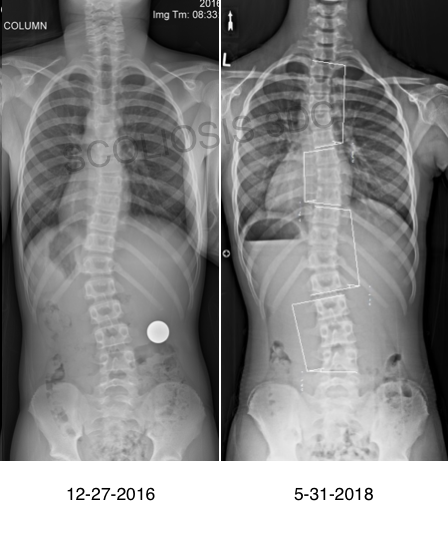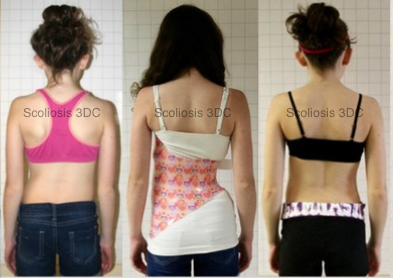
Risser sign is one indicator that should be considered during the management of scoliosis. Risser 0 is the first Risser stage when ossification of the epiphyseal plate over the iliac crest has not yet begun. In simpler terms, new bone has not yet started forming at the top of the pelvis – indicating significant remaining growth. It can be concerning when scoliosis is diagnosed at Risser 0 as the risk of curve progression is greatest during this time of skeletal immaturity.
When a child with a mild curve presents to an orthopedic surgeon at the Risser 0 stage, surgeons will often tend to recommend a wait-and-see approach. We disagree with that protocol, and instead view an early diagnosis as an opportunity to use growth as a corrective factor (1) to improve the curvature and postural appearance. Parents need to learn as much as possible about scoliosis to be able to make strategic decisions for optimal management.
To be upfront, there is some limited literature stating that very mild curves may resolve (2). However, with Cobb angles ≥20º this isn’t a likely scenario. It’s why we advocate being proactive and treating sooner rather than later. As Christa Lehnert-Schroth used to tell Dr. Marc, “no curve is too small to treat.”
Let’s Break Things Down
If your child is Risser 0 and the scoliosis is mild at diagnosis (under 20º Cobb), effectively managing the curve with appropriate conservative treatment should be possible if you do not wait too long to act and your child is compliant. Scoliosis can progress quickly during periods of growth, so it is important to get ahead of the curve whenever possible.
Growing kids with moderate (25º- 49º Cobb angle) and severe scoliosis (50º+) at Risser 0 present the biggest challenges. This isn’t to imply there isn’t hope. We’ve treated many cases who have successfully stabilized curvature, and many who have reduced curvature to some degree. However, in these cases, there is work to do and the road may be long.
Girls diagnosed with scoliosis at Risser sign 0 are usually pre-menarchal and typically pre-adolescence or a very young adolescent. Boys may be Risser 0 well into their early teen years.
To understand the potential of the Scoliosis 3DC® program, here are two cases of patients who began their scoliosis journey at Risser stage 0:
Case 1
This patient first came to see us at the end of 2016. At the time, she was a Risser 0 with Cobb angle measurements of 17º and 25º. Her treatment came at the perfect time as she was growing rapidly. 8 months later, she was fit with a second brace as she had outgrown the first one.

She had an out-of-brace x-ray (24 hours out-of-brace) showing measurements of 14° and 13° – a nearly 50% improvement in the lower curve! While she continued under our care through skeletal maturity her result at Risser 3 demonstrates what compliance after the right scoliosis program can do. Low Cobb angle numbers at skeletal maturity means her risk of future curve progression is minimal.
Case 2

If you follow us, you’ve probably seen previous mentions of this girl’s case. Her treatment at Scoliosis 3DC® began when she was eleven years old (Risser 0). Within 18 months her scoliosis was declared “resolved.”

This patient was incredibly compliant, following Dr. Marc’s recommendations exactly since day 1. Technically, she no longer has scoliosis (her curve last measured 6º and spinal curves <10º are not considered to be scoliosis) and she is now an adult. When she had outgrown her second brace, when it was time to be measured for her third brace, Dr. Marc decided she could forego bracing, even though she still had considerable growth potential.
Fortunately, she’s a Boston girl so she was able to check in regularly with Dr. Marc right thru Risser 5. She continued her Schroth exercises right through skeletal maturity but since she is fully grown, those can be discontinued as well. Looking at her when she reached skeletal maturity it was impossible to recognize that she started with a 26º Cobb angle!
Previous blog: Risser Sign
Next blog: Risser 1
(1) Mehta M.H. Growth as a corrective force in the early treatment of progressive infantile scoliosis. J. Bone Joint Surg. Br. 2005;87(9):1237–1247.
(2) Modi HN, Suh S-W, Yang J-H, Hong J-Y, Venkatesh K, Muzaffar N. Spontaneous regression of curve in immature idiopathic scoliosis – does spinal column play a role to balance? An observation with literature review. Journal of Orthopaedic Surgery and Research. 2010;5:80. doi:10.1186/1749-799X-5-80.

